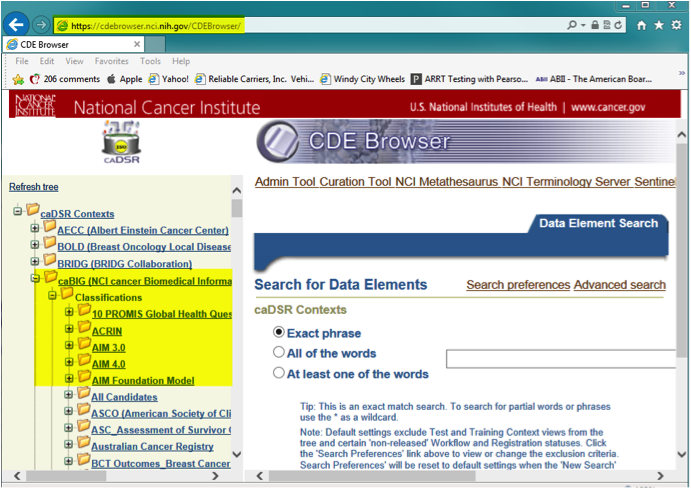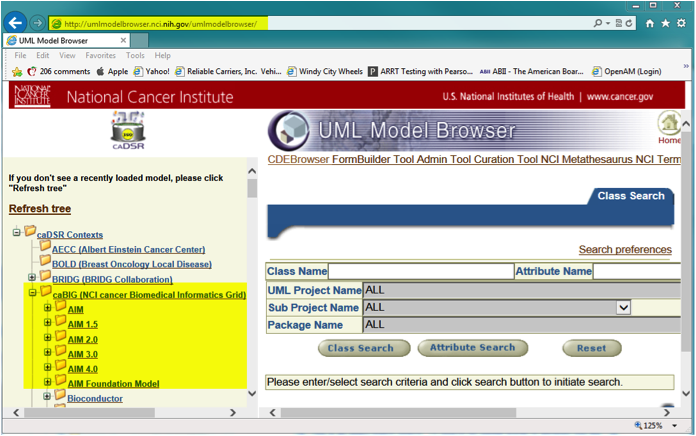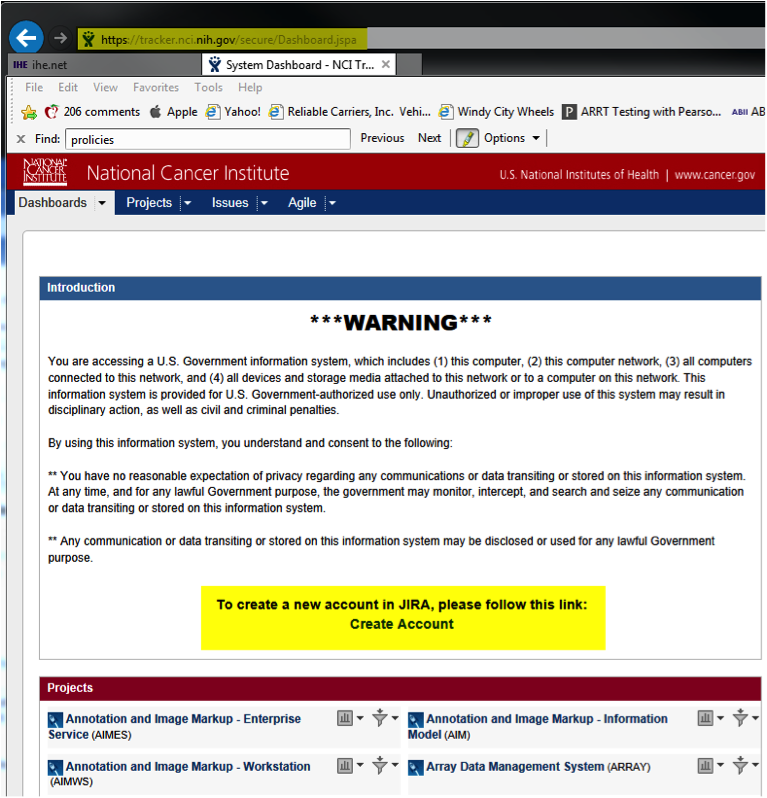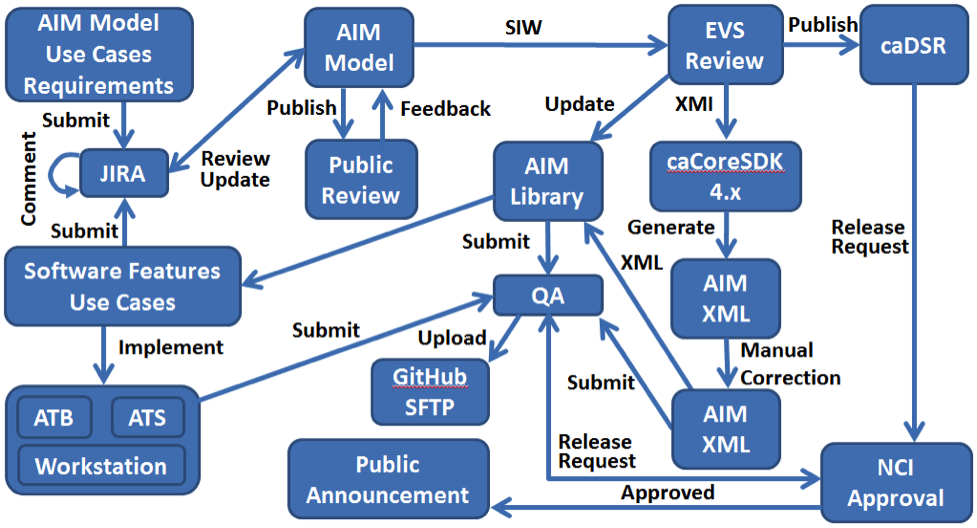Topics in this guide include:
AIM Principles of Governance
The AIM project was conceived and developed by imaging workspace subject matter experts at NCI's cancer Biomedical Informatics Grid (caBIG®). It is currently being supported by NCIP. AIM model 1.0 to 2.0 passed the caBIG® silver compatibility model process. All models underwent a curation process using Semantic Integration Workbench (SIW) to ensure that all new and existing classes and attributes in AIM models conform to and are interoperable with the Common Data Elements (CDEs) standard. All reviewed AIM models that the Enterprise Vocabulary Services (EVS) team approved are uploaded to the cancer Data Standards Registry and Repository (caDSR). The NCIP imaging community maintains AIM official models on NCI caDSR. Some of the earlier AIM models had been retired from CDEs because newer AIM models maintain compatibility to the prior AIM models. The active AIM models can be viewed from CDE browser and UML model browser, figure 1 and figure 2, respectively.
Figure 1. CDE Browser: https://cdebrowser.nci.nih.gov/CDEBrowser/
Figure 2. UML Model Browser: http://umlmodelbrowser.nci.nih.gov/umlmodelbrowser/
In the following sections, leaders of the imaging program at NCIP and its representatives along with the principle investigator of the AIM project describe the participants, policies, and procedures of the AIM project.
Participants
The NCIP imaging community conducts regular telephone conferences and face-to-face meetings with imaging community users and experts. The NCIP leaders also participate, exchange, and collect requirements about the use of imaging studies with other NCI communities. These groups of people are stakeholders in improving AIM interoperability and model usage. They provide requirements, suggestions, model reviews, and feedback. The imaging community is an open forum. An individual and representatives of an organization can participate in the community activities by contacting Ulrike Wagner. The current key personnel are as follows.
| Role | Name |
|---|---|
| Government Sponsor | Edward Helton |
| Government Project Manager | Jonathan Lin |
| Technical Project Manager | Ulrike Wagner |
| Principle Investigator | Pattanasak Mongkolwat |
Policies
The imaging community establishes a set of rules that govern the modification and enhancement of AIM models as well as AIM toolkits used to create AIM related software products. The policies meet the Center for Biomedical Informatics and Information Technology (CBIIT) open source community requirements for making NCI supported projects available for public use and contributions.
AIM Model Policy
- The AIM principle investigator under supervision from NCI imaging leaderships maintains the AIM model.
- A requestor for any AIM improvements must create an account with NCI JIRA, https://tracker.nci.nih.gov/secure/Dashboard.jspa, and participate in the imaging community activities. See Figure 3, which follows.
Figure 3. Requesting a JIRA Account
- Enhancements to and new requirements for the AIM model must be submitted to NCI JIRA at https://tracker.nci.nih.gov/browse/AIM. Do the following to request an enhancement or new requirement.
- Create an issue as a User Story issue type, Figure 4.
Figure 4. A Request Type of "User Story"
- Describe the use case and examples.
- Identify what needs to be added or changed or suggest a solution.
- The requestor must be willing to communicate with and provide sufficient information to the AIM team members in order to clarify, if any, requirements and use cases.
- The requestor shall provide contact information such as e-mail address and telephone number.
- Approval and rejection process – see the Acceptance Policy
AIM Toolkits and Related Software Products Policy
- A requestor for any toolkit and software products improvements must create an account with NCI JIRA at https://tracker.nci.nih.gov/secure/Dashboard.jspa and participate in the imaging community activities.
- A requestor must enter new requests in an appropriate AIM project. There are three related AIM projects:
- Annotation and Image Markup – Information Model (AIM)
- AIM library and ANIVATR
- https://tracker.nci.nih.gov/browse/AIM
- Annotation and Image Markup – Enterprise Service (AIMES)
- AIM Template Builder (ATB)
- AIM Template Service (ATS)
- https://tracker.nci.nih.gov/browse/AIMES
- Annotation and Image Markup – Workstation (AIMWS)
- AIM Workstations
- https://tracker.nci.nih.gov/browse/AIMWS
- Create an issue as "New Feature", "Bug" or "Improvement"
- Select "New Feature", Figure 5, to recommend a new capability to an AIM-related software.
- Annotation and Image Markup – Information Model (AIM)
Figure 5. A Request Type of "New Feature"
- Select "Bug", Figure 6, to report software defect.
Figure 6. A Request Type of "Bug"
- Select "Improvement", Figure 7, to request an enhancement to the existing software feature.
Figure 7. A Request Type of "Improvement"
- A requestor must be willing to communicate with and provide sufficient information to the AIM team members in order to clarify, if any, requirements and use cases.
- The requestor shall provide contact information such as e-mail address and telephone number.
- Software contributions to the existing software products are welcomed and encouraged. Contributors must register for an NCI JIRA account.
- A new contribution to be considered for inclusion to an existing software product must be entered into the respective AIM JIRA. The AIM development team will review and approve it.
- The contributor must be willing to communicate with and provide sufficient information to the AIM team members in order to clarify, if any, requirements, use cases and quality assurance process.
- Any software contribution must be released under BSD 3 license
- Approval and rejection process – see the Acceptance Policy
AIM Acceptance Policy
A request for enhancing or changing the AIM model and AIM-related software shall follow the following guidelines.
- All requests must meet the goal of capturing data directly related to and enhance the capability of the AIM model and its related software.
- Depending on the current activity and stage of development, an issue may be assigned one of the following stages after having discussion sessions with the requester.
| Stage | Description |
|---|---|
| Open | An issue has been submitted and reviewed by the AIM team. A member of the AIM team reviews the request and works with the requester to ensure the problem and use cases are clear and complete. |
| In Progress | An issue has been accepted and will be resolved in the AIM project. |
| Hold | An issue has been put on hold for future considerations in a next improvement and development cycle. A member of the AIM team will contact the requester. |
| Resolved as Fixed Issue | An issue has been accepted and included in the AIM project. |
| Resolved as Duplicate | An issue has been identified as a duplicated issue. The AIM team will link the duplicated issue to an existing issue. |
| Resolved as Won't Fix Issue | An issue has been identified as an issue that cannot be fixed for particular reasons. A member of the AIM team shall provide reasonable explanation and/or contact the requester. |
| Resolved as Cannot Reproduce Issue | An issue has been identified as an issue that cannot be reproduced. A member of the AIM team shall provide reasonable explanation and/or contact the requester. |
The AIM team reviews completed requests and votes to approve for inclusion in the AIM model and related software products. The AIM team reserves the rights to present to and consult with NCI imaging leadership, EVS team members, and imaging experts for a resolution. Results of the review might be approval (Resolved as Fixed Issue), reject (Resolved as Won't Fix Issue or Resolved as Duplicate), or return to requestor (Resolved as Cannot Reproduce Issue) with suggested change in direction. Any return to requestor will be delivered through the original JIRA issue. The status changes to "Resolved as Fixed Issue" or "Resolved as Won't Fix Issue or Resolved as Duplicate" based on the decision of the AIM team and its advisors.
Procedures
The imaging community brings imaging experts and users of in vivo imaging together to address requirements and AIM usage. Community members use AIM library and derived AIM software products and provide feedback to the AIM team. The diagram, Figure 8, depicts the procedures of the AIM project. Any requests for improving, enhancing, and bug fixing must be entered into NCI JIRA as described in section 1.2. There are three sub-projects under the AIM project: AIM Model, AIM Enterprise Service, and AIM workstation.
New inquiry and enhancement requests for the AIM model or "AIM Model Use Cases Requirements" must be submitted to https://tracker.nci.nih.gov/browse/AIM. Once the AIM team accepts a new request to be included in AIM model, the model and accompanying documentation describing any additions and changes are released for public review and comment. The AIM team and its advisors review incoming feedback and work with requested parties who provide comments and suggestions. If need be, the AIM team releases a revised AIM model and repeats a public review process. All corresponding messages of a JIRA issue shall be entered in the NCI JIRA. After a model has been finalized, the AIM team performs the SIW [1] process and submits the model to the EVS team for review and approval. Once the model is approved, it is submitted to the EVS team to be published to the caDSR [2]. At the same time, the AIM team makes a request to release a new AIM model from the NCI program officer before a public announcement can be released to the public. While the new AIM model is being submitted to caDSR, the AIM team also works on a new version of the AIM C++ software library as well as an AIM XML schema for public use. Changes to the library are also incorporated to ATB, ATS and the AIM workstation. Both the AIM library and AIM XML schema will have to go through a software quality assurance (QA) process. After they pass the QA process, the AIM team makes a request to the NCI program officer for public release of the library and schema. Once approved, the library and schema are uploaded to NCI AIM GitHub for public use. A software and schema releases will be publicly announced.
Any new software features, improvements, and bug reports must be submitted to NCI JIRA under the appropriate software products per the policy explained in "AIM Toolkits and Related Software Products Policy" in section 1.2. The AIM team and its advisors review incoming requests. The AIM team works with interested parties who provide requests and suggestions. All corresponding messages of a JIRA issue shall be entered into NCI JIRA. Accepted requests are scheduled for implementation according to available resources and time allowed for each software development cycle. Each request is associated with a version of a software release. Once a software version is ready for a release, it must go through a QA process until all identifiable software bugs have been resolved. After a software version passes the QA process, it is uploaded to the NCI SFTP. At the same time, the AIM team makes a request for software release with the NCI program officer. An announcement is issued after an approval has been granted.
Figure 8. Procedures for the AIM Project
References
- Semantic Integration Workbench. URL: https://wiki.nci.nih.gov/x/QYEI Access 2013-09-30.
- Cancer Data Standards Registry and Repository. URL: https://wiki.nci.nih.gov/display/caDSR/caDSR+Wiki#caDSRWiki-AboutcaDSR Access 2013-09-30.








